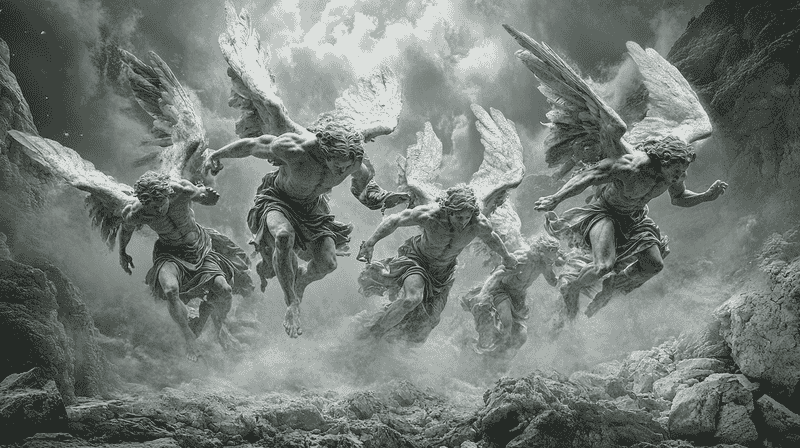Was Satan An Angel: The Origins of The Names
To understand the connection (or frankly, lack thereof) between Lucifer and Satan, we first need to see where these names came from. Words carry histories, and in this case, those histories tell two very different stories.
Lucifer: The Morning Star
The name itself comes from Latin and translates to “light-bringer” or “morning star.” It was originally used to describe the planet Venus. In Roman mythology, Lucifer wasn’t a sinister figure at all. It was actually a poetic representation of Venus’ brilliance and fleeting appearance.
Things took a turn when this word made its way into the Bible—specifically into the Latin Vulgate translation by St. Jerome. In Isaiah 14:12, a passage describing the downfall of the Babylonian king reads:
How you have fallen from heaven, O morning star, son of the dawn!
Jerome translated “morning star” into Lucifer, and suddenly the name took on a darker tone. This started to be a thing over the centuries as theologians reinterpreted this passage to refer to Satan’s fall from grace.
But hold up—Isaiah wasn’t talking about the devil at all. He was condemning a prideful Babylonian ruler. The name Lucifer was later connected to Satan’s story by association, definitely not by original intent.
Satan: The Adversary
Unlike Lucifer, Satan’s name has Hebrew roots. The word satan means “adversary” or “accuser” and originally wasn’t a name at all—it was a job description. In the Hebrew Bible, ha-satan (literally “the adversary”) shows up as a kind of divine prosecutor. He was the character in Job who questioned whether Job’s faith was genuine or just a result of God’s blessings.
Interestingly, ha-satan isn’t portrayed as inherently evil in these early texts. He’s more like a skeptical observer. He's someone tasked with testing humanity’s faith. The image of Satan as a full-blown embodiment of evil only crystallized later. By the time the New Testament was written, Satan had become synonymous with the ultimate spiritual enemy, the tempter, and the ruler of a rebellious, fallen kingdom.
So, while Lucifer and Satan are now often treated as one and the same, their names and roles began worlds apart. One started as a poetic nod to the morning star, the other as a cosmic adversary in a celestial courtroom. But how did these two figures merge into the ultimate antagonist we know today?
The Biblically Accurate Devil: Clearing Up the Confusion
When it comes to understanding Lucifer and Satan, a lot of the confusion comes from how they’re mentioned (or not mentioned) in the Bible. If you’re expecting a neat and tidy story about these two as the same entity, prepare to be surprised. The Bible has a lot to say about both, but not in the way most people think.
Lucifer: The One-Hit Wonder of the Bible
Believe it or not, the name “Lucifer” makes exactly one appearance in the Bible—just one. You’ll find it in Isaiah 14:12, where the prophet is addressing the downfall of a proud and oppressive king of Babylon.
In the original Hebrew text, there’s no mention of “Lucifer” at all. The Hebrew word helel is used, which translates to “shining one” or “morning star.” It wasn’t until the 4th century, when St. Jerome translated the Bible into Latin, that helel became “Lucifer.” At the time, this wasn’t a name for the devil—it was a poetic way of describing the king’s fall from grace.
So, how did Lucifer end up being seen as Satan?
Later Christian interpretations linked this passage to the New Testament idea of Satan being cast out of heaven. Over time, the association stuck, and the poetic “light-bringer” was recast as the ultimate symbol of rebellion and pride. But originally? Lucifer was a metaphor for a human ruler who flew too close to the sun.
Satan: The Prosecutor Turned Tempter
Unlike Lucifer, Satan is a recurring figure in the Bible, although his role evolves over time. In the Old Testament, Satan isn’t the horned figure ruling a fiery underworld. He’s more like a heavenly prosecutor. In Job 1:6-12, for example, ha-satan (“the adversary”) shows up in God’s court to challenge Job’s faith. He doesn’t act out of pure malice but as a tester, someone carrying out a role within God’s larger plan.
In the New Testament Satan takes on a much darker and more sinister role. He’s the tempter in the wilderness (Matthew 4:1-11), the deceiver, and the accuser of humanity. By this point, Satan has become the embodiment of evil spirits, the ultimate enemy of God and His people.
And here’s where things get even more layered. When the New Testament describes Satan's fall, it borrows imagery that echoes another ancient text: the Book of Enoch. In Luke 10:18, Jesus says:
I saw Satan fall like lightning from heaven.
In Revelation 12:7-9, there’s an epic war in heaven where the dragon and his angels are cast down. These passages seem to build on the themes first introduced in Enoch, where a group of rebellious angels—known as the Watchers—are cast out of heaven after defying God.
The Book of Enoch doesn’t name Satan or Lucifer specifically, but its vivid storytelling about fallen angels who corrupt humanity laid the groundwork for later Christian interpretations. Over time, these threads from Enoch, Isaiah, and Revelation were woven together, creating the image of Satan as a fallen angel—a role that wasn’t fully developed in the earliest biblical texts.
 The Greek Influence: From Adversary to Horned Devil
The Greek Influence: From Adversary to Horned Devil
Here’s where things get a little mythological. The Bible itself doesn’t describe Satan as a horned, red-skinned devil holding a pitchfork. Those features didn’t come from scripture—they came from ancient cultural influences, particularly Greek mythology.
The Greeks had a deep fascination with the Underworld, ruled by Hades, who wasn’t inherently evil but was associated with death, darkness, and judgment. Over time, the imagery of Hades and his domain influenced early depictions of Satan as Christianity spread into the Greco-Roman world.
Another Greek god often linked to Satan’s modern imagery is Pan, the mischievous half-goat deity of the wild. Pan was often depicted with horns, cloven hooves, and a tail—features that became symbolic of chaos, lust, and temptation. As Christianity sought to distinguish itself from pagan religions, these traits were demonized (quite literally) and grafted onto Satan’s evolving persona.
The blending of these mythologies with Christian theology created a visual shorthand for Satan that felt both terrifying and familiar to ancient audiences. By the time the Middle Ages rolled around, artists and writers leaned heavily into this imagery, cementing the horned devil in the collective imagination.
Get Closer to God Today
4.9
Average Rating
|Over 5 Million Downloads
How Lucifer and Satan Became One
If the Bible gives us the framework, then history and theology add the finishing touches (some may say with a heavy hand). Lucifer and Satan didn’t start as the same character, but over the centuries, their identities merged, thanks to a combination of theological interpretation, cultural storytelling, and a dash of medieval drama.
 Early Christian Thought: Making Connections
Early Christian Thought: Making Connections
In the early days of Christianity, theologians were working to piece together a cohesive understanding of evil, rebellion, and the cosmic battle between good and bad. Naturally, they started linking the dots between various biblical passages.
Theologians like Origen and St. Augustine were some of the first who started to create the links. Origen, in the 3rd century, interpreted Isaiah 14 allegorically. He saw Lucifer’s fall as a reference to Satan’s rebellion against God. By the time Augustine came around, this idea had solidified. Lucifer wasn’t just a fallen king, but Satan himself, cast out of heaven for his pride.
Medieval Drama: The Devil Gets a Makeover
If the early Church Fathers laid the groundwork, the medieval period added the special effects. During this time, stories about Satan became more vivid, more dramatic, and, frankly, more terrifying.
Medieval writers and artists leaned into the imagery of Satan as a horned, fiery demon ruling over hell. Think of Dante’s "Inferno", where Satan is portrayed as a grotesque, three-headed beast trapped in ice, or John Milton’s "Paradise Lost", which paints Lucifer as a tragic antihero leading a rebellion against God. These works didn’t just entertain. As we can see centuries later, they shaped the public’s perception of who Satan was and what he looked like.
This period also saw the rise of demonology, where scholars cataloged demons and their hierarchies, often connecting them back to fallen angels. The line between Lucifer and Satan blurred further, as both figures came to symbolize ultimate rebellion against God.
Modern Theology: Still Debating
Fast forward to today, and the question of whether Lucifer and Satan are the same still sparks debate. Some theologians argue that the association is more tradition than text, pointing out that the Bible itself doesn’t explicitly link the two. Others hold onto the centuries-old interpretation that Lucifer and Satan are just two names for the same fallen angel.
Pop culture, of course, has had its say as well. The idea of Satan as Lucifer is deeply embedded in our collective consciousness through TV shows, movies, and social media.
The journey from two separate names to one unified figure is a testament to how stories evolve over time. The Bible gave us the raw materials, theologians connected the dots, and culture turned the whole thing into a larger-than-life tale of rebellion, pride, and ultimate downfall.
While Christianity has largely merged the identities of Lucifer and Satan, other belief systems have a different take. For example, Luciferianism, a modern spiritual philosophy, draws a sharp distinction between the two.
In Luciferian thought, Lucifer is seen as a symbol of enlightenment, personal freedom, and rebellion against oppressive systems. He represents the pursuit of knowledge and individual empowerment, not the embodiment of evil. For Luciferians, the name Lucifer harkens back to its original meaning—the “light-bringer” or “morning star”—and is associated with challenging authority to achieve personal growth.
On the other hand, Satan, as interpreted by Luciferians, is often linked more closely to the Christian concept of evil and the tempter archetype. Some see Satan as a separate force entirely, while others dismiss him as a creation of Christian theology. Where one tradition sees rebellion as a sin, another may see it as liberation.




